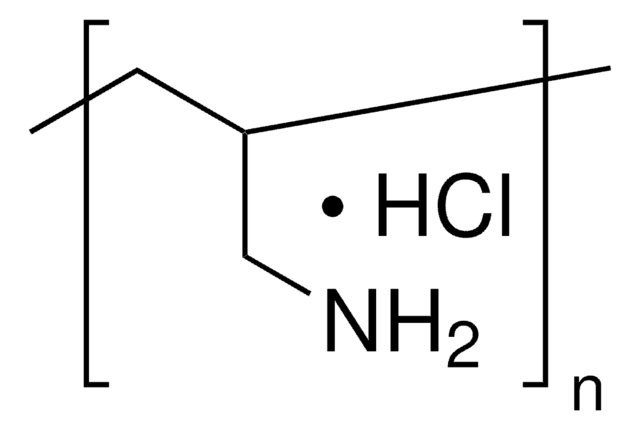522376
Poly(diallyldimethylammonium chloride) solution
average Mw <100,000 (very low molecular weight), 35 wt. % in H2O
Synonym(s):
PDADMAC
About This Item
Recommended Products
mol wt
average Mw <100,000 (very low molecular weight)
Quality Level
concentration
35 wt. % in H2O
refractive index
n20/D 1.417
viscosity
100-200 cP(25 °C)
density
1.09 g/mL at 25 °C
InChI
1S/C8H16N.ClH/c1-5-7-9(3,4)8-6-2;/h5-6H,1-2,7-8H2,3-4H3;1H/q+1;/p-1
InChI key
GQOKIYDTHHZSCJ-UHFFFAOYSA-M
Looking for similar products? Visit Product Comparison Guide
General description
Application
Storage Class
10 - Combustible liquids
wgk_germany
WGK 1
flash_point_f
>212.0 °F - closed cup
flash_point_c
> 100 °C - closed cup
ppe
Eyeshields, Gloves, multi-purpose combination respirator cartridge (US)
Choose from one of the most recent versions:
Already Own This Product?
Find documentation for the products that you have recently purchased in the Document Library.
Customers Also Viewed
Articles
Recently, layer-by-layer (LbL) assembly has emerged as a versatile, gentle and, simple method for immobilization of functional molecules in an easily controllable thin film morphology.1,2 In this short review, we introduce recent advances in functional systems fabricated by using the mild, yet adaptable LbL technique.
We present an article that discusses two applications in particular; first, using these layers as polyelectrolyte membranes to control permeability.
Our team of scientists has experience in all areas of research including Life Science, Material Science, Chemical Synthesis, Chromatography, Analytical and many others.
Contact Technical Service
![Poly[(2-ethyldimethylammonioethyl methacrylate ethyl sulfate)-co-(1-vinylpyrrolidone)] average Mw <1,000,000 by GPC, 20 wt. % in H2O](/deepweb/assets/sigmaaldrich/product/structures/334/533/03fcaede-76a6-4b5a-a992-9565ea1ace4a/640/03fcaede-76a6-4b5a-a992-9565ea1ace4a.png)